人教版(2019)必修第二册Unit 2 Wildlife protection Reading and Thinking 课件(共23张PPT)
文档属性
| 名称 | 人教版(2019)必修第二册Unit 2 Wildlife protection Reading and Thinking 课件(共23张PPT) | 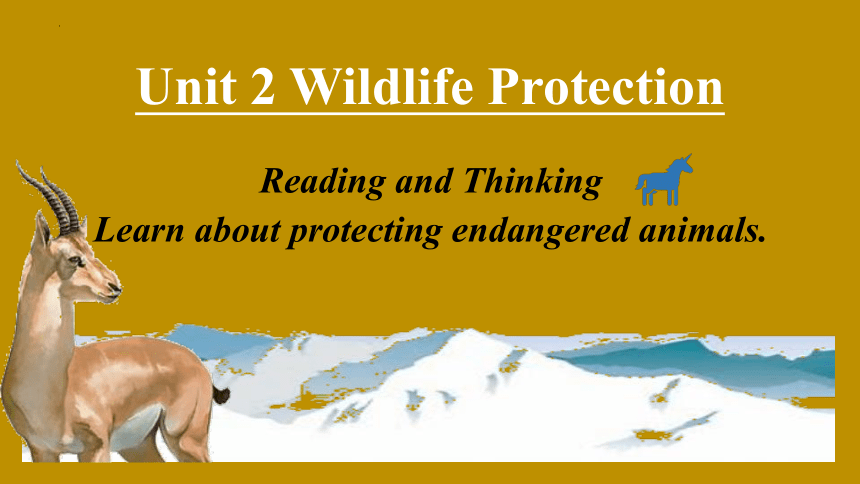 | |
| 格式 | pptx | ||
| 文件大小 | 671.7KB | ||
| 资源类型 | 教案 | ||
| 版本资源 | 人教版(2019) | ||
| 科目 | 英语 | ||
| 更新时间 | 2024-04-18 19:28:16 | ||
图片预览

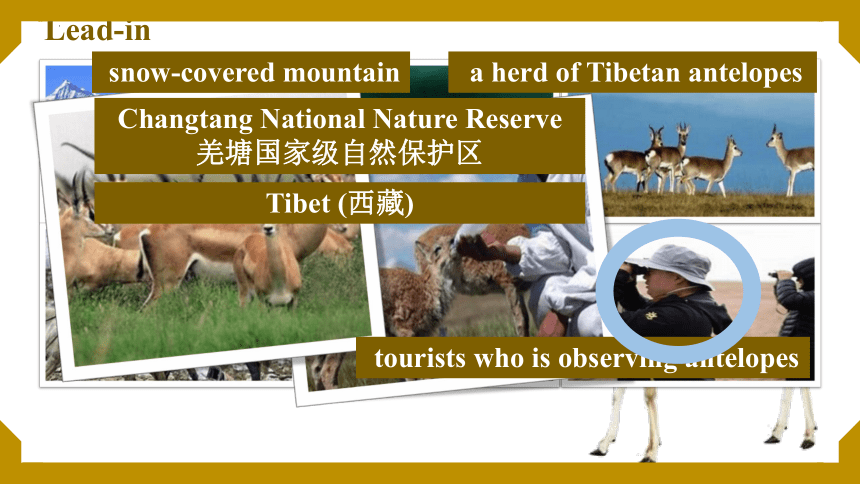
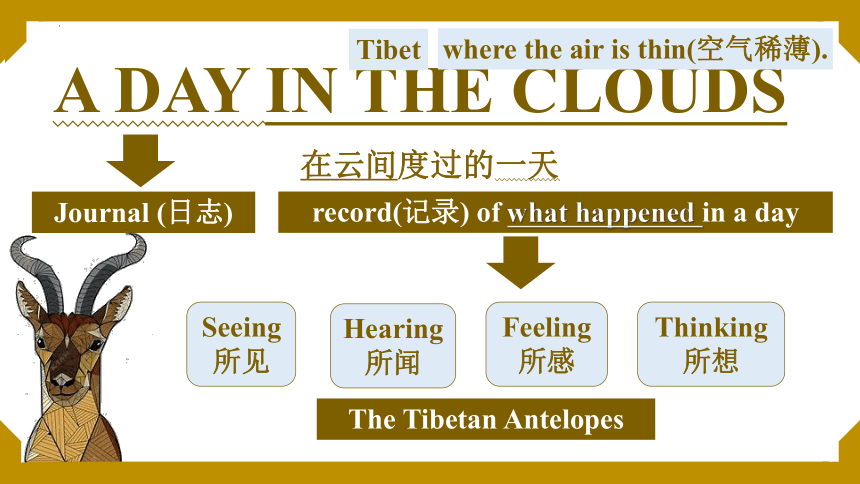
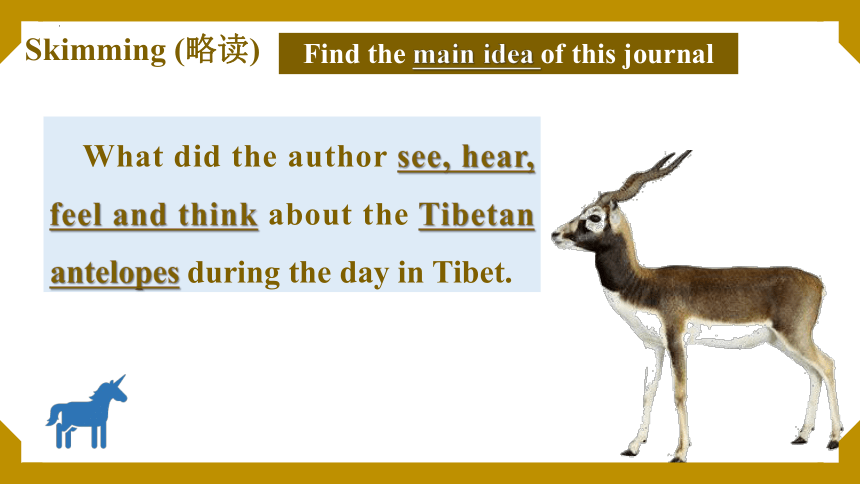
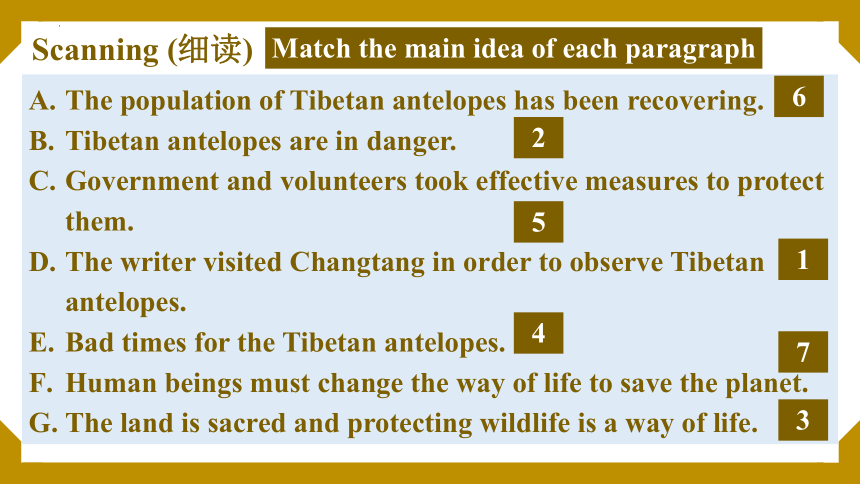
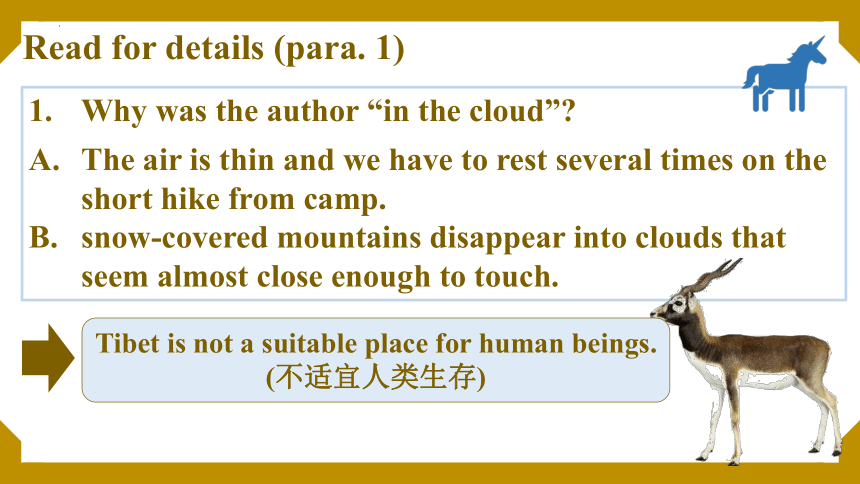
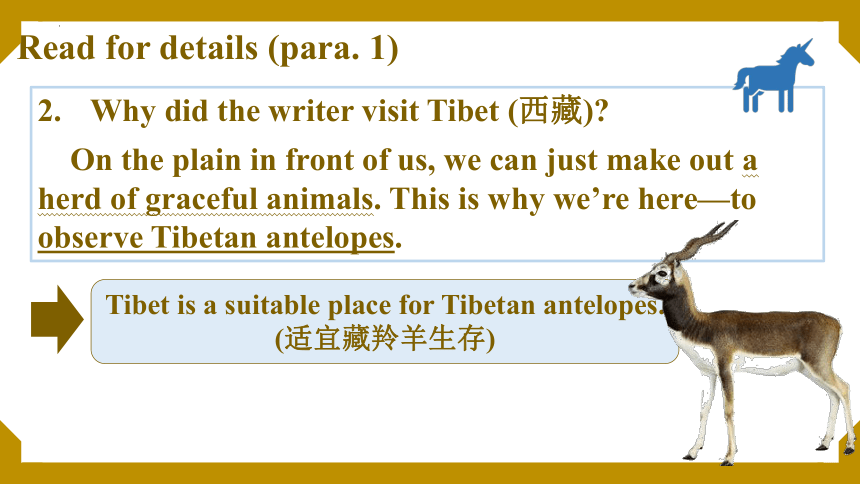
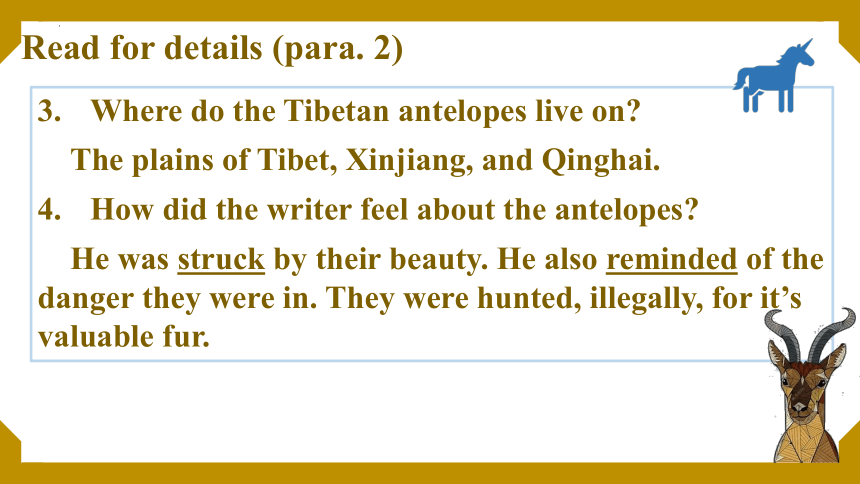
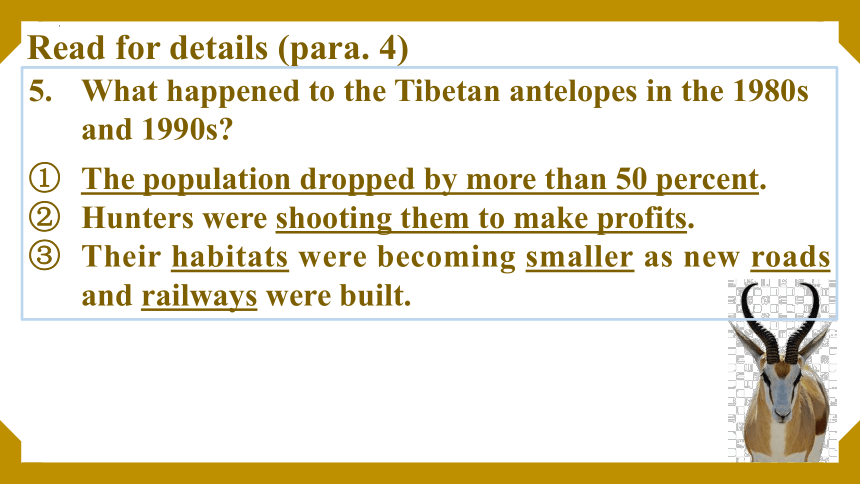
内容文字预览
(共23张PPT)
Unit 2 Wildlife Protection
Reading and Thinking
Learn about protecting endangered animals.
Lead-in
snow-covered mountain
a herd of Tibetan antelopes
tourists who is observing antelopes
Changtang National Nature Reserve
羌塘国家级自然保护区
Tibet (西藏)
a day in the clouds
在云间度过的一天
Journal (日志)
record(记录) of what happened in a day
Tibet
where the air is thin(空气稀薄).
Seeing
所见
Hearing
所闻
Feeling
所感
Thinking
所想
The Tibetan Antelopes
What did the author see, hear, feel and think about the Tibetan antelopes during the day in Tibet.
Find the main idea of this journal
Skimming (略读)
Match the main idea of each paragraph
Scanning (细读)
The population of Tibetan antelopes has been recovering.
Tibetan antelopes are in danger.
Government and volunteers took effective measures to protect them.
The writer visited Changtang in order to observe Tibetan antelopes.
Bad times for the Tibetan antelopes.
Human beings must change the way of life to save the planet.
The land is sacred and protecting wildlife is a way of life.
6
2
5
1
4
7
3
Read for details (para. 1)
Why was the author “in the cloud”
The air is thin and we have to rest several times on the short hike from camp.
snow-covered mountains disappear into clouds that seem almost close enough to touch.
Tibet is not a suitable place for human beings. (不适宜人类生存)
Read for details (para. 1)
Why did the writer visit Tibet (西藏)
On the plain in front of us, we can just make out a herd of graceful animals. This is why we’re here—to observe Tibetan antelopes.
Tibet is a suitable place for Tibetan antelopes. (适宜藏羚羊生存)
Read for details (para. 2)
Where do the Tibetan antelopes live on
The plains of Tibet, Xinjiang, and Qinghai.
How did the writer feel about the antelopes
He was struck by their beauty. He also reminded of the danger they were in. They were hunted, illegally, for it’s valuable fur.
Read for details (para. 4)
What happened to the Tibetan antelopes in the 1980s and 1990s
The population dropped by more than 50 percent.
Hunters were shooting them to make profits.
Their habitats were becoming smaller as new roads and railways were built.
Read for details (para. 5)
What did people do to help protect the Tibetan antelope
The Chinese government placed it under national protection.
Volunteers watched over the antelopes day and night to keep them safe from attacks.
Bridges and gates were added to let the antelopes move easily and keep them safe from cars and trains.
Read for details (para. 6)
Were the measures effective
Yes! The antelope population has recovered and in June 2015, the Tibetan antelope was removed from the endangered species list.
Can the government stop the protection now
No! the threats to the Tibetan antelopes have not yet disappeared.
A Day in the Clouds
See _______________________________
Hear _______________________________
Feel _______________________________
Think _______________________________
What did the author see, hear, feel and think about the Tibetan antelopes during the day in the clouds
Seeing
snow-covered mountains disappearing into clouds.
the antelopes moving slowly across the green grass.
beauty
Hearing
Changtang National Nature Reserve
bad times for the Tibetan antelope
measures to protect the Tibetan antelopes
effects achieved after years of protection
Why and how to protect antelopes
Zhaxi
Feeling
the writer was struck by their beauty
the writer was angry with hunters.
Thinking
changing our way of life (改变生活方式)
existing in harmony with nature (与自然和谐共生)
harmony
Mind map (思维导图)
Protecting the Tibetan antelope
Why
How
Results
Further actions
Hunters ____________________________.
Habitats ___________________________.
Government ____________________________.
_______ and ______ were added for safety.
Volunteers _________________________.
The antelope population ______________.
In June 2015, _______________________.
Change ___________________________.
Exist _____________________________.
shot them to make profit
were getting smaller
placed it under national protection
Bridges
gates
watched over them day and night
has recovered
they were removed from the endangered species list
our way of life
in harmony with nature
hearing
thinking
the purpose of this article
Literal meaning: is the usual, basic meaning of the words. (字面意义)
Implied meaning: is suggested but not directly expressed. (隐含意义)
Read for details
Read the sentences below, and decide if each idea is the literal meaning(L) of the text or only implied(I) by the text.
_____ When they first saw the antelopes, they were very far away.
I
We can just make out a herd of graceful animals.
_____ We should not buy goods made from endangered animals.
I
They were hunted illegally for their valuable fur (毛皮).
Read the sentences below, and decide if each idea is the literal meaning(L) of the text or only implied(I) by the text.
_____ Human activities are threating animals and plants.
I
The reserve is a shelter for them, but threats to them still exist.
_____ The Tibetan antelope is not an endangered species now.
L
In June 2015, the Tibetan antelope was removed from the endangered species list (濒危物种名录).
a day in the clouds
Summary
Tibet where the air is thin.
To observe Tibetan antelope.
Protecting the Tibetan antelope
Why
How
Results
Further actions
Change our way of life.
Exist in harmony with nature.
Post-reading
The writer says that we must change our way of life and exist in harmony with nature.
Do you agree What should we change immediately
We should stop buying goods made from endangered animals.
It is important to further educate people to protect wildlife.
Thank you~
When the buying stops, the killing can too.
— Wild Aid
Unit 2 Wildlife Protection
Reading and Thinking
Learn about protecting endangered animals.
Lead-in
snow-covered mountain
a herd of Tibetan antelopes
tourists who is observing antelopes
Changtang National Nature Reserve
羌塘国家级自然保护区
Tibet (西藏)
a day in the clouds
在云间度过的一天
Journal (日志)
record(记录) of what happened in a day
Tibet
where the air is thin(空气稀薄).
Seeing
所见
Hearing
所闻
Feeling
所感
Thinking
所想
The Tibetan Antelopes
What did the author see, hear, feel and think about the Tibetan antelopes during the day in Tibet.
Find the main idea of this journal
Skimming (略读)
Match the main idea of each paragraph
Scanning (细读)
The population of Tibetan antelopes has been recovering.
Tibetan antelopes are in danger.
Government and volunteers took effective measures to protect them.
The writer visited Changtang in order to observe Tibetan antelopes.
Bad times for the Tibetan antelopes.
Human beings must change the way of life to save the planet.
The land is sacred and protecting wildlife is a way of life.
6
2
5
1
4
7
3
Read for details (para. 1)
Why was the author “in the cloud”
The air is thin and we have to rest several times on the short hike from camp.
snow-covered mountains disappear into clouds that seem almost close enough to touch.
Tibet is not a suitable place for human beings. (不适宜人类生存)
Read for details (para. 1)
Why did the writer visit Tibet (西藏)
On the plain in front of us, we can just make out a herd of graceful animals. This is why we’re here—to observe Tibetan antelopes.
Tibet is a suitable place for Tibetan antelopes. (适宜藏羚羊生存)
Read for details (para. 2)
Where do the Tibetan antelopes live on
The plains of Tibet, Xinjiang, and Qinghai.
How did the writer feel about the antelopes
He was struck by their beauty. He also reminded of the danger they were in. They were hunted, illegally, for it’s valuable fur.
Read for details (para. 4)
What happened to the Tibetan antelopes in the 1980s and 1990s
The population dropped by more than 50 percent.
Hunters were shooting them to make profits.
Their habitats were becoming smaller as new roads and railways were built.
Read for details (para. 5)
What did people do to help protect the Tibetan antelope
The Chinese government placed it under national protection.
Volunteers watched over the antelopes day and night to keep them safe from attacks.
Bridges and gates were added to let the antelopes move easily and keep them safe from cars and trains.
Read for details (para. 6)
Were the measures effective
Yes! The antelope population has recovered and in June 2015, the Tibetan antelope was removed from the endangered species list.
Can the government stop the protection now
No! the threats to the Tibetan antelopes have not yet disappeared.
A Day in the Clouds
See _______________________________
Hear _______________________________
Feel _______________________________
Think _______________________________
What did the author see, hear, feel and think about the Tibetan antelopes during the day in the clouds
Seeing
snow-covered mountains disappearing into clouds.
the antelopes moving slowly across the green grass.
beauty
Hearing
Changtang National Nature Reserve
bad times for the Tibetan antelope
measures to protect the Tibetan antelopes
effects achieved after years of protection
Why and how to protect antelopes
Zhaxi
Feeling
the writer was struck by their beauty
the writer was angry with hunters.
Thinking
changing our way of life (改变生活方式)
existing in harmony with nature (与自然和谐共生)
harmony
Mind map (思维导图)
Protecting the Tibetan antelope
Why
How
Results
Further actions
Hunters ____________________________.
Habitats ___________________________.
Government ____________________________.
_______ and ______ were added for safety.
Volunteers _________________________.
The antelope population ______________.
In June 2015, _______________________.
Change ___________________________.
Exist _____________________________.
shot them to make profit
were getting smaller
placed it under national protection
Bridges
gates
watched over them day and night
has recovered
they were removed from the endangered species list
our way of life
in harmony with nature
hearing
thinking
the purpose of this article
Literal meaning: is the usual, basic meaning of the words. (字面意义)
Implied meaning: is suggested but not directly expressed. (隐含意义)
Read for details
Read the sentences below, and decide if each idea is the literal meaning(L) of the text or only implied(I) by the text.
_____ When they first saw the antelopes, they were very far away.
I
We can just make out a herd of graceful animals.
_____ We should not buy goods made from endangered animals.
I
They were hunted illegally for their valuable fur (毛皮).
Read the sentences below, and decide if each idea is the literal meaning(L) of the text or only implied(I) by the text.
_____ Human activities are threating animals and plants.
I
The reserve is a shelter for them, but threats to them still exist.
_____ The Tibetan antelope is not an endangered species now.
L
In June 2015, the Tibetan antelope was removed from the endangered species list (濒危物种名录).
a day in the clouds
Summary
Tibet where the air is thin.
To observe Tibetan antelope.
Protecting the Tibetan antelope
Why
How
Results
Further actions
Change our way of life.
Exist in harmony with nature.
Post-reading
The writer says that we must change our way of life and exist in harmony with nature.
Do you agree What should we change immediately
We should stop buying goods made from endangered animals.
It is important to further educate people to protect wildlife.
Thank you~
When the buying stops, the killing can too.
— Wild Aid
